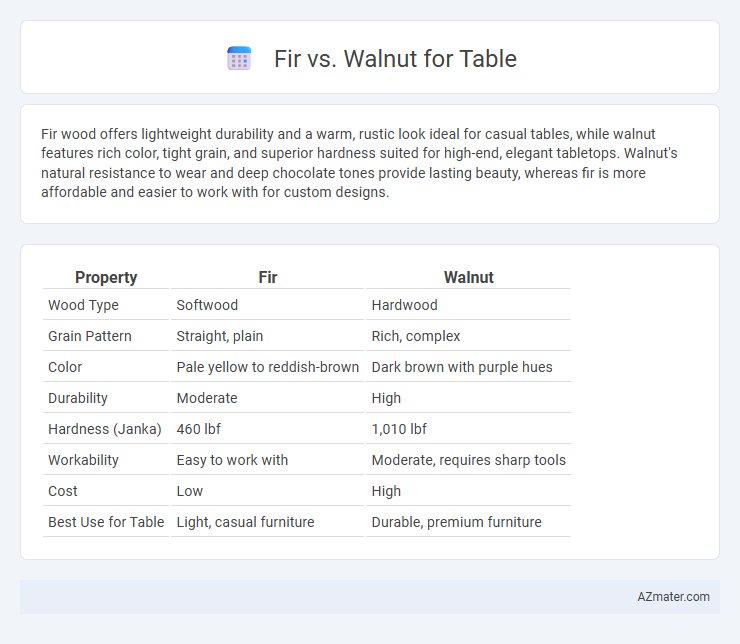Fir wood offers lightweight durability and a warm, rustic look ideal for casual tables, while walnut features rich color, tight grain, and superior hardness suited for high-end, elegant tabletops. Walnut's natural resistance to wear and deep chocolate tones provide lasting beauty, whereas fir is more affordable and easier to work with for custom designs.
Table of Comparison
| Property | Fir | Walnut |
|---|---|---|
| Wood Type | Softwood | Hardwood |
| Grain Pattern | Straight, plain | Rich, complex |
| Color | Pale yellow to reddish-brown | Dark brown with purple hues |
| Durability | Moderate | High |
| Hardness (Janka) | 460 lbf | 1,010 lbf |
| Workability | Easy to work with | Moderate, requires sharp tools |
| Cost | Low | High |
| Best Use for Table | Light, casual furniture | Durable, premium furniture |
Introduction to Fir and Walnut as Table Materials
Fir wood, known for its straight grain and pale reddish-brown color, offers excellent strength and stability, making it a popular choice for durable and lightweight tables. Walnut, prized for its rich, dark brown hue and fine, complex grain patterns, provides exceptional hardness and aesthetic appeal, often used in high-end, elegant furniture. Both woods balance durability and beauty but cater to different stylistic preferences and functional requirements in table design.
Key Differences: Fir vs Walnut Wood
Fir wood is lighter, softer, and less durable than walnut, making it more suitable for budget-friendly, rustic tables with a lighter appearance. Walnut wood features a rich, dark color with tight grain patterns, offering superior hardness, durability, and resistance to wear, ideal for high-end, elegant furniture pieces. The cost difference is significant, as walnut is typically much more expensive due to its premium quality and aesthetic appeal compared to fir.
Appearance and Grain Patterns
Fir wood features a light, creamy color with subtle reddish or yellowish hues, showcasing straight and uniform grain patterns that create a clean, minimalist aesthetic ideal for contemporary tables. Walnut, by contrast, presents a rich, deep brown to purplish-black color with dramatic, swirling grain patterns, offering a luxurious and striking visual appeal perfect for statement furniture pieces. The distinct grain variation in walnut adds depth and character, while fir's consistent grain provides a smooth and understated elegance.
Durability and Hardness Comparison
Walnut is significantly harder and more durable than Fir, with a Janka hardness rating of about 1,010 lbf compared to Fir's lower rating around 660 lbf. This makes Walnut more resistant to dents, scratches, and everyday wear, ideal for high-use tables requiring long-lasting strength. Fir, while softer, offers moderate durability suitable for decorative tables or lighter usage but may show wear more quickly over time.
Cost and Availability
Fir wood is generally more affordable and widely available compared to walnut, making it a cost-effective choice for table construction. Walnut is a premium hardwood known for its rich color and grain, but it commands a higher price and can be less readily found in local lumber markets. When budgeting for table materials, fir offers easier access and lower costs, while walnut provides luxury and durability at a premium expense.
Maintenance and Longevity
Fir tables require regular sealing and occasional sanding to maintain their softwood surface, as they are more prone to dents and scratches compared to hardwoods. Walnut tables offer superior durability with natural resistance to wear and fewer maintenance needs, often only requiring periodic oiling to preserve their rich color and grain. Over time, walnut's dense structure ensures greater longevity and sustained aesthetic appeal in high-use environments.
Suitability for Different Table Styles
Fir wood offers a light, uniform grain and a soft texture, making it suitable for rustic and country-style tables where a natural, warm appearance is desired. Walnut features a rich, dark color with a pronounced grain pattern, ideal for elegant, modern, or traditional tables that require a striking visual impact and durability. Both woods perform well structurally, but fir's affordability suits casual or budget-conscious projects, while walnut's premium quality fits high-end, statement furniture.
Environmental Impact and Sustainability
Fir wood is generally considered more sustainable due to its faster growth rate and abundance in managed forests, which reduces deforestation pressure. Walnut, being slower-growing and in higher demand, often has a larger environmental footprint linked to habitat disruption and longer carbon sequestration periods. Choosing fir for tables promotes lower ecological impact and supports renewable forestry practices compared to the more resource-intensive walnut.
Pros and Cons: Fir Tables
Fir tables offer a lightweight, affordable option with a straight grain that provides a smooth surface ideal for painting or staining. Their softness makes them prone to dents and scratches, reducing long-term durability compared to hardwood like walnut. Fir is also more susceptible to moisture damage, requiring proper sealing to maintain its appearance and structural integrity.
Pros and Cons: Walnut Tables
Walnut tables are prized for their rich, dark color and striking grain patterns, offering exceptional durability and resistance to wear, making them ideal for long-lasting furniture. However, walnut wood tends to be more expensive compared to fir, which may limit budget-friendly options. While walnut provides a luxurious and elegant appearance, it is heavier and harder to work with, requiring careful maintenance to prevent scratches and dents.

Infographic: Fir vs Walnut for Table
 azmater.com
azmater.com